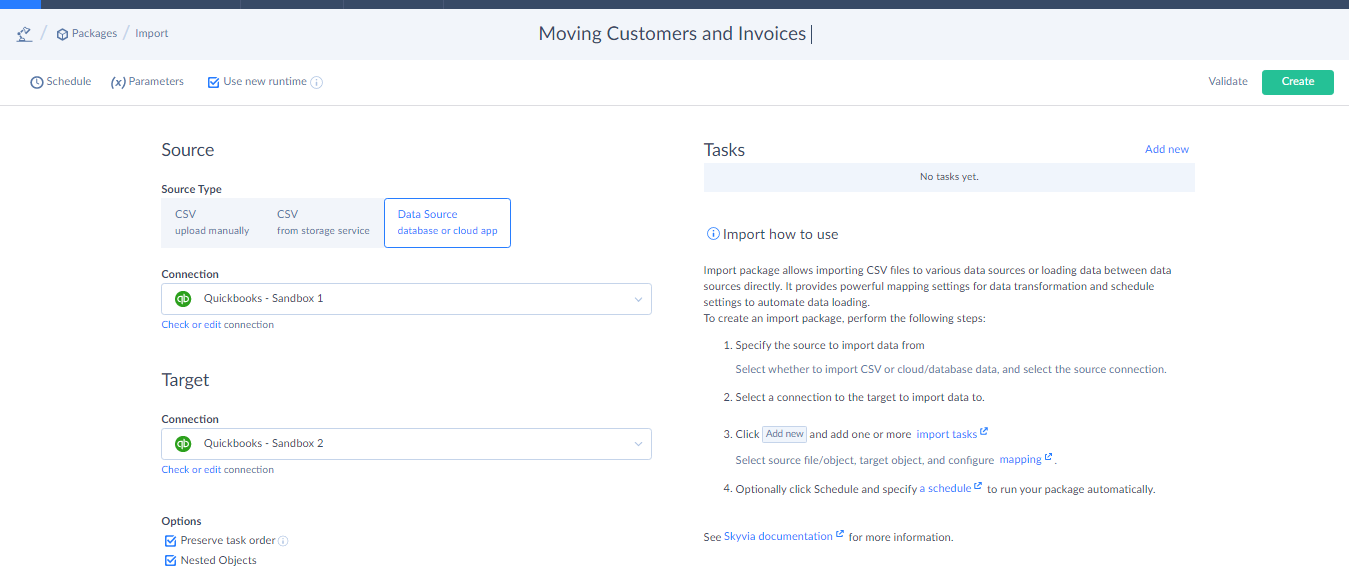
Optionally, if you want this package to only sync new invoices from Salesforce to QuickBooks, you can select Inserted to load only new opportunities every time the package is run. IMPORT DATA INTO QUICKBOOKS INVOICES HOW TO
You can read more on how to configure filters and conditions in the Filter Settings topic.

If some Opportunities do not have OpportunityLineItem, records will fail in the import package.

It is important in order to map correctly the Invoice Line field. Please note that here you need to filter only Opportunities, which have OpportunityLineItem. For example, if you need to insert only specific Opportunities, you can filter them by ID as shown below. Optionally, below you can add a filter by clicking +Condition and setting a specific condition.
Next select the Opportunity object from the Source drop-down list. You can read more about task editor modes here. When the task editor opens, select the task editor mode you want to work with - Simple or Advanced. To configure settings, perform the following quick steps: On this task editor tab, you select a source object to load data from and specify filter settings to filter source data the way you need. For our scenario, we need to create and configure settings for one import task. Click the Add new link to open the Task Editor.Įach import package can contain one or more import tasks, which are configured in the convenient task editor. Select the Nested Objects checkbox to be able to map the columns of the nested Quickbooks Line object to the corresponding columns from the Salesforce OpportunityLineItem. In the next drop-down list, select QuickBooks as target As you import data from the cloud app, click Data Source database or cloud app and select Salesforce as source from the Connection drop-down list. Select the Use new runtime checkbox to activate the Nested Objects option. Please note that if you omit this step, the package name will remain Untitled in the list of created packages In the open package editor, rename your package by clicking and editing the package name. Follow these simple steps to adjust general package settings: To successfully create and run a new package, you need to adjust general package settings and configure task editor settings. Read the Connecting to Salesforce and Connecting to QuickBooks topics to find out how to configure settings of necessary cloud apps as well as view the Connections topic to know how to create a connection following several simple steps. For our scenario, we create connections to Salesforce (source) and QuickBooks (target) respectively. You will use them as source and target in your import package. Creating Connectionsįirst, you need to create connections in Skyvia, using Salesforce and QuickBooks connectors. Make sure you have selected the Use new runtime checkbox in your import package before adding a task. Please note that the Nested Objects functionality is available when the new data integration runtime is selected. To find out how to create an import package and configure mapping settings of nested objects correctly, read our step-by-step instruction below. 
For example, if the Opportunity object has three line items, then Skyvia generates 3 lines for Invoice in QuickBooks Online. When you map fields of a nested object, you do not need to define how many lines should be for each Invoice.

However, when you select the Nested Objects checkbox in your import package, the nested Line object is divided into separate fields, and it becomes possible to map its columns to the corresponding columns from the Salesforce OpportunityLineItem. The Invoice Line field is not represented as separate fields, it has an array data structure. The main problem of such an import operation is that when you import data from Salesforce Opportunities into QuickBooks Invoices, there are no fields in Salesforce that correspond to the Invoice Line field in QuickBooks, and, to successfully load data, you need to map the required Invoice Line field to a constant in the form of an array. In this tutorial, we will show how to configure Salesforce - QuickBooks integration: import data from Salesforce Opportunities to QuickBooks Online Invoices. How to Import Data from Salesforce Opportunities to QuickBooks Invoices








 0 kommentar(er)
0 kommentar(er)
